How Do You Determine If Your Tow Vehicle Is Right For Your Trailer?
This is one of those “Mystery Questions” where everyone has an opinion. Frankly, some opinions are, well, dangerous. I can remember looking for a tow vehicle when we were thinking about upgrading our travel trailer to ‘Blue Streak‘, our International 25 CCD Airstream. When we asked the “truck dealer” about towing capabilities they focused only on the pulling weight capability of the truck – i.e., “How much does your trailer weigh (6500#) oh, no problem, this truck can pull 7500#.”
The newbie part of my brain said, “great” – however, the been towing trailers for several years part of my brain said, “what about hitch weight, what about payload, what about brake controller, What about ??????” Basically, there is more to matching your Tow Vehicle to your Travel Trailer than just what the trailer weight is and what the truck can pull!
Let’s consider what we did (Disclaimer: the following is my opinion, you are responsible to check the accuracy of all information):
First ‘Blue Streak‘ our International 25 CCD Airstream.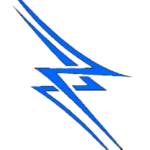
There are 4 important numbers to know about your trailer; 1) the UBW or Unit Base Weight (empty trailer) without gear or water [includes batteries and propane], 2) the NCC or Net Carrying Capacity, 3) the GVWR or Gross Vehicle Weight Rate [equals UBW+NCC], and 4) the Hitch or Tongue Weight. Obviously, items 1,3 and 4 are the key numbers to consider for towing. [Side Note: a US gallon of water adds 8.3#, so for Blue Streak 39@8.3=324# before gear. What this means is the max addition of weight for NCC allowed is reduced to 756#.]
Here is our International 25 CCD Working Specs for towing:

The GVWR information is on the trailer registration plaque found (usually) on the outside of the trailer. The UBW (empty trailer weight) and Hitch Weight can be obtained from the trailer manufacturer specification sheet.
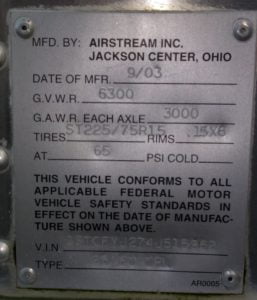

Next is ‘Red Dragon‘ our F-150HD FX4.
Recall the Dealer discussion above – generally they were correct. The basic F-150 has the towing capacity 0f 7500# and it does come with a factory brake controller and back-up camera options (nice right!).
I have seen pictures of an Airstream being pulled by a bicycle! 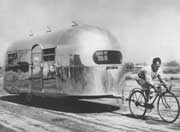 (just so you know I’m not kidding here is a picture) I read all the time in the Airstream Forum about people towing with all types of vehicles. However, on flat terrain all things are possible but that does not mean it’s safe or smart. The question is if you travel where there are hills and mountains what do you want your tow vehicle to accomplish safely. The last thing you want to experience is the “tail wagging the dog syndrome”.
(just so you know I’m not kidding here is a picture) I read all the time in the Airstream Forum about people towing with all types of vehicles. However, on flat terrain all things are possible but that does not mean it’s safe or smart. The question is if you travel where there are hills and mountains what do you want your tow vehicle to accomplish safely. The last thing you want to experience is the “tail wagging the dog syndrome”.
When we looked for a Tow Vehicle there were 5 must things we looked for; 1) Vehicle Curb weight, 2) Gross Vehicle Weight Rating, 3) Gross Combined Vehicle Rating, 4) Payload Capacity, And 5) Towing Capacity.
Here is our Truck Working Specs:

What does this all mean?
- Curb Weight: The weight of the vehicle sitting at the curb with all standard options and no occupants (people+dogs), cargo or load.
- GVWR is the Gross Vehicle Weight Rating. This is the Maximum Allowable Weight your truck can carry (making this F-150 Heavy Duty).
- GCVWR is Gross Combined Vehicle Weight Rating. This is the Maximum Allowable Weight your truck and trailer can weigh combined.
- Payload or Cargo Capacity: This is the maximum weight of occupants (people+dogs) + cargo + hitch weight (load) you can add to your tow vehicle (truck) with out exceeding your GVWR. (To find the payload capacity of your truck look for the sticker on the drivers side door frame or subtract the curb weight from your GVWR for maximum capacity).
- Towing capacity is the maximum amount of weight you can tow. This can be found in your owners manual or on the truck manufacturers Official Towing Guide (often located on their website).
It is important to know that most of this information I have talked about so far is located on the stickers found on the inside driver-side door pillar of your tow vehicle (see mine below).

Below is a great short discussion about what I have written above.
When we put it all together running the numbers using the basic formula we begin to get a general snap shot of the truck/trailer marriage.
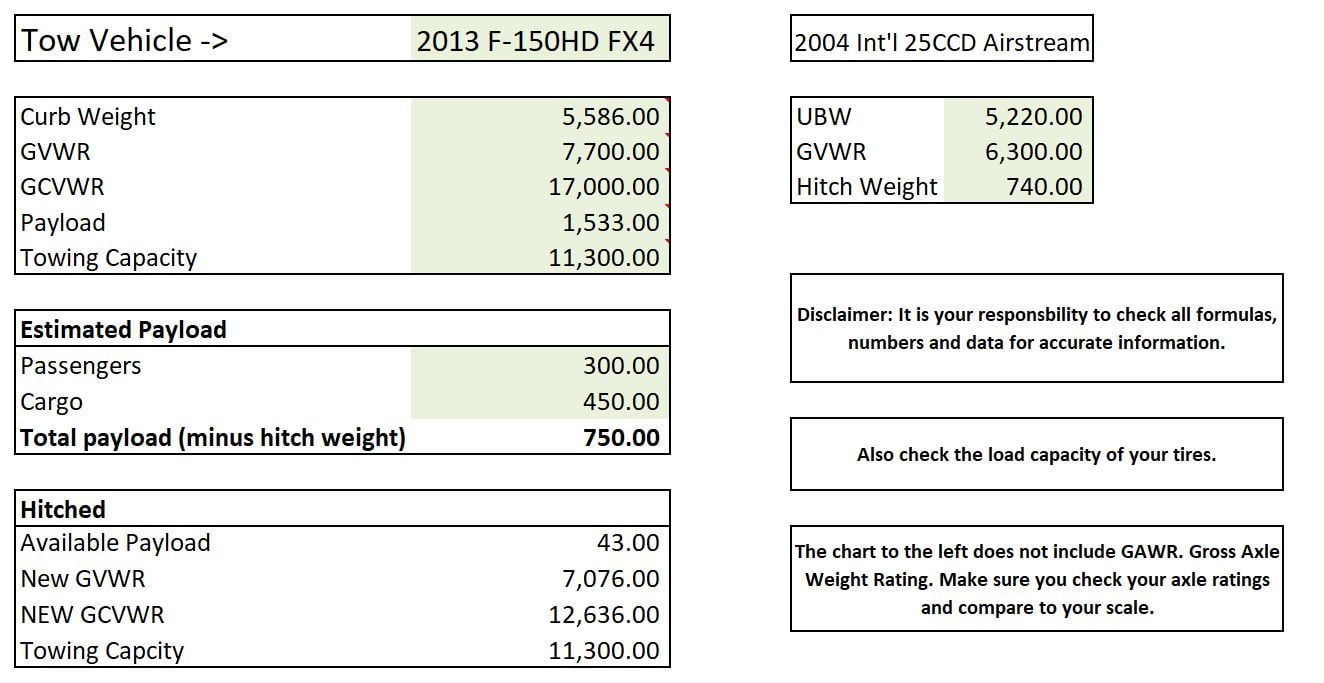
There are other aspects of a Tow Vehicle that are very important to consider. This begins to narrow the picture.
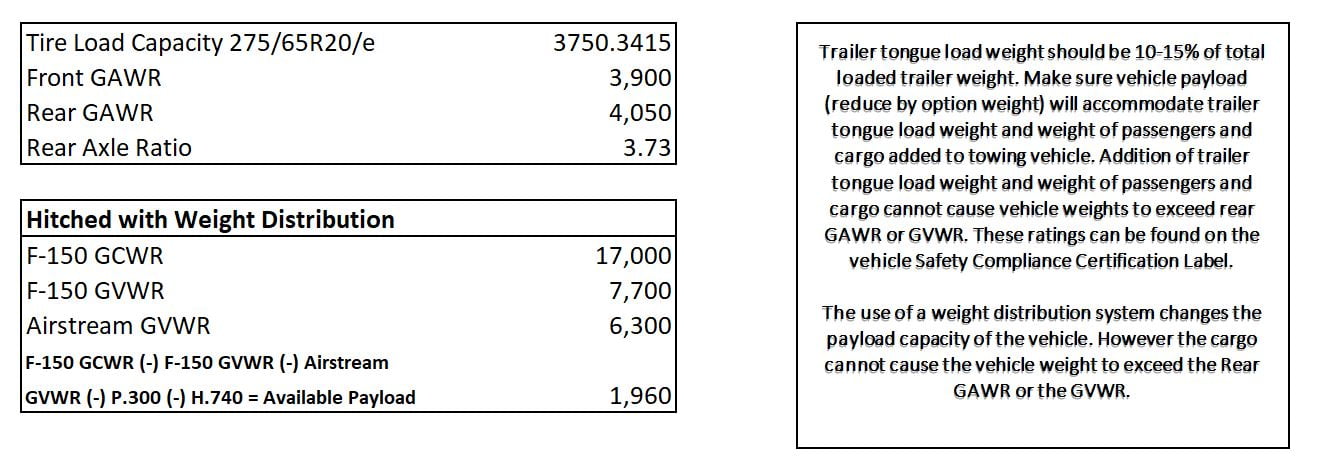
Just a quick note on the use of Weight Distribution/Sway Control Systems.

A weight distribution hitch (or weight distribution system) helps to ensure a smooth, level ride and allows you to tow at the maximum capacity allowed by your Tow Vehicle. It also helps to correct tow vehicle sag, improve steering and stopping, and—when used with sway control—correct trailer sway (which is the primary cause of towing accidents). Basically, a weight distribution hitch will help keep your towing setup level and make sure the weight of your trailer doesn’t cause undue stress on your vehicle. It is highly recommended when:
- Your trailer weight (GVWR) is more than 50% of your vehicle’s weight (GVWR)
- The rear of your tow vehicle sags when the trailer is hooked up
- You experience trailer sway
- Your tow vehicle’s headlights point upward
- You find it difficult to steer or stop your rig
- You want to tow to the highest capacity allowed by your trailer hitch

“with” weight-distribution system
Personally, we tow ‘Blue Streak‘ using a Reese Straight-line Dual Cam Weight Distribution/Sway Control System. This balances the distribution of weight on 4 axles between the Airstream and our FX4. While this has little to do with what we are discussing here (Marriage of Tow Vehicle to Trailer) per se, it has every thing to do with safety, control and the ability to maximize the capability of this marriage ?
To Conclude:
As you can see from the data above our Tow Vehicle is more than capable to handle our Airstream in all driving conditions. There are several other aspects of our Tow Vehicle which I deemed as important as well.
- Red Dragon comes with a factory installed Brake Controller.
- Has the factory Max Tow Package (11,300#).
- Optional 7700# GVWR means Red Dragon is F-150 Heavy Duty (with the BFG tires and SumoSprings safely adds 400# payload capacity = 1933# basically 30# under the Vehicle Max Load Capacity and well under the axle capacity) .
- Has the factory installed power Tow Mirrors (a must for towing a trailer wider than the truck).
- Red Dragon is an F-150HD 3.5L ecoboost which produces 365HP and 420ft/lb of torque (with great gas mileage – towing/loaded about 22l per 100km @ 95km per hour).
- Red Dragon is a SuperCrew with 6.6 box @ 157 inch wheelbase with 3.73 locking rear end.
- Red Dragon is a FX4 – meaning 4×2 wheel drive with 4×4 high/low and locking rear wheels available.
- Red Dragon also equipped with electronic Tow/Haul, Trailer Sway Control and Down Hill Assist.
Red Dragon also is equipped with the Off-Road Package. We upgraded this with BFGoodrich all-terrain TA KO2 lt275/65r20/e 126s 3750/3415 – the weakest link is always the tires. So we looked at load ratings and decided to go bullet proof with E Rated tires primarily because 90% of our camping is Boondocking (gravel/forestry roads).
We run Red Dragon at the Ford inflation specs of 35 psi without load and adjust up to 45 psi when towing Blue Streak (depending on the truck bed load).
[I should mention we have also upgraded the tires on Blue Streak to GoodYear Endurance which are also E rated. We run them at 65 psi inflation according to GoodYear specs]
This was our journey to mate Blue Streak (our “tail”) with Red Dragon (our “dog”) ?
Form concept by Mark of KYD which I give thanks

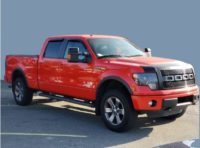
CommentThank you for all of the information, very helpful
Administrator Response:
You’re welcome – trust you will find your dream Airstream, we did. ?